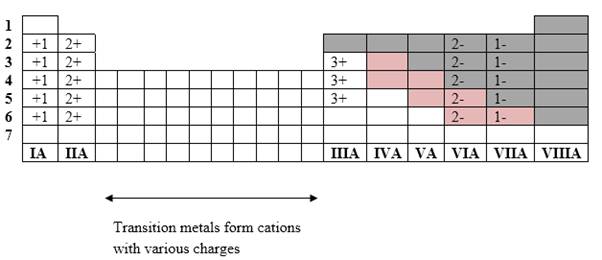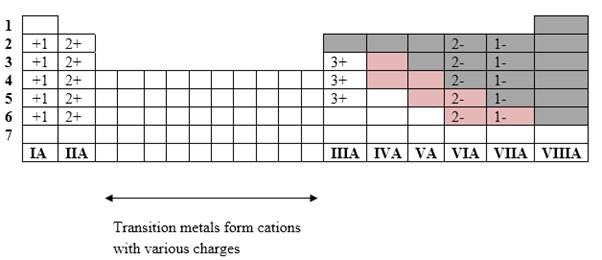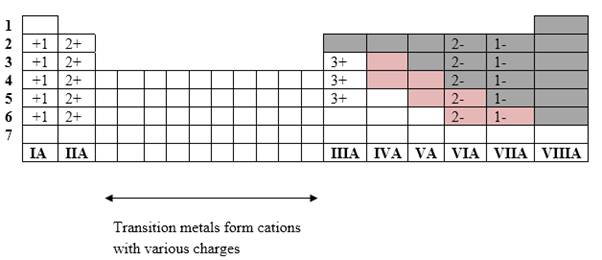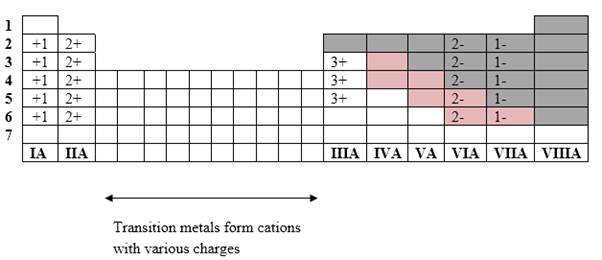
Concept explainers
(a)
Interpretation:
Predict the simple binary compound that can be formed by the use of electron configuration of the simple ions which are formed by those elements.
Concept Introduction:
Electron configuration describes the positions of electrons of an atom. Depending on that the periodic table is created. Periodic table further defines the simple ion that can be formed by any element. And using those ions, simple binary compounds can be produced.

Order in which orbitals fill to produce the atoms in periodic table as follows:
Simplest ion form by each group as follows:

If it’s a compound made by a combination of metal and nonmetal elements, called as ionic compounds.
Ionic chemical compound must have a zero charge. If a compound contains ions;
1. Both positive ions (cations) and negative ions (anions) must be there.
2. No: of cations and anions collectively should produce a zero-net charge.
Answer to Problem 45CR
Explanation of Solution
Al and Cl
(b)
Interpretation:
Predict the simple binary compound that can be formed by the use of electron configuration of the simple ions which are formed by those elements.
Concept Introduction:
Electron configuration describes the positions of electrons of an atom. Depending on that the periodic table is created. Periodic table further defines the simple ion that can be formed by any element. And using those ions, simple binary compounds can be produced.

Order in which orbitals fill to produce the atoms in periodic table as follows:
Simplest ion form by each group as follows:

If it’s a compound made by a combination of metal and nonmetal elements, called as ionic compounds.
Ionic chemical compound must have a zero charge. If a compound contains ions;
1. Both positive ions (cations) and negative ions (anions) must be there.
2. No: of cations and anions collectively should produce a zero-net charge.
Answer to Problem 45CR
Explanation of Solution
Na and N
(c)
Interpretation:
Predict the simple binary compound that can be formed by the use of electron configuration of the simple ions which are formed by those elements.
Concept Introduction:
Electron configuration describes the positions of electrons of an atom. Depending on that the periodic table is created. Periodic table further defines the simple ion that can be formed by any element. And using those ions, simple binary compounds can be produced.

Order in which orbitals fill to produce the atoms in periodic table as follows:
Simplest ion form by each group as follows:

If it’s a compound made by a combination of metal and nonmetal elements, called as ionic compounds.
Ionic chemical compound must have a zero charge. If a compound contains ions;
1. Both positive ions (cations) and negative ions (anions) must be there.
2. No: of cations and anions collectively should produce a zero-net charge.
Answer to Problem 45CR
Explanation of Solution
Mg and S
(d)
Interpretation:
Predict the simple binary compound that can be formed by the use of electron configuration of the simple ions which are formed by those elements.
Concept Introduction:
Electron configuration describes the positions of electrons of an atom. Depending on that the periodic table is created. Periodic table further defines the simple ion that can be formed by any element. And using those ions, simple binary compounds can be produced.

Order in which orbitals fill to produce the atoms in periodic table as follows:
Simplest ion form by each group as follows:

If it’s a compound made by a combination of metal and nonmetal elements, called as ionic compounds.
Ionic chemical compound must have a zero charge. If a compound contains ions;
1. Both positive ions (cations) and negative ions (anions) must be there.
2. No: of cations and anions collectively should produce a zero-net charge.
Answer to Problem 45CR
CaO.
Explanation of Solution
Ca and O
(e)
Interpretation:
Predict the simple binary compound that can be formed by the use of electron configuration of the simple ions which are formed by those elements.
Concept Introduction:
Electron configuration describes the positions of electrons of an atom. Depending on that the periodic table is created. Periodic table further defines the simple ion that can be formed by any element. And using those ions, simple binary compounds can be produced.

Order in which orbitals fill to produce the atoms in periodic table as follows:
Simplest ion form by each group as follows:

If it’s a compound made by a combination of metal and nonmetal elements, called as ionic compounds.
Ionic chemical compound must have a zero charge. If a compound contains ions;
1. Both positive ions (cations) and negative ions (anions) must be there.
2. No: of cations and anions collectively should produce a zero-net charge.
Answer to Problem 45CR
Explanation of Solution
K and O
(f)
Interpretation:
Predict the simple binary compound that can be formed by the use of electron configuration of the simple ions which are formed by those elements.
Concept Introduction:
Electron configuration describes the positions of electrons of an atom. Depending on that the periodic table is created. Periodic table further defines the simple ion that can be formed by any element. And using those ions, simple binary compounds can be produced.

Order in which orbitals fill to produce the atoms in periodic table as follows:
Simplest ion form by each group as follows:

If it’s a compound made by a combination of metal and nonmetal elements, called as ionic compounds.
Ionic chemical compound must have a zero charge. If a compound contains ions;
1. Both positive ions (cations) and negative ions (anions) must be there.
2. No: of cations and anions collectively should produce a zero-net charge.
Answer to Problem 45CR
Explanation of Solution
Sr and Br
( Simple ion =
Want to see more full solutions like this?
Chapter 12 Solutions
Introductory Chemistry: Foundation - Text (Looseleaf)
- Identify and provide a concise explanation of a specific analytical instrument capable of detecting and quantifying trace compounds in food samples. Emphasise the instrumental capabilities relevant to trace compound analysis in the nominated food. Include the specific application name (eg: identification and quantification of mercury in salmon), outline a brief description of sample preparation procedures, and provide a summary of the obtained results from the analytical process.arrow_forwardIdentify and provide an explanation of what 'Seperation Science' is. Also describe its importance with the respect to the chemical analysis of food. Provide specific examples.arrow_forward5. Propose a Synthesis for the molecule below. You may use any starting materials containing 6 carbons or less (reagents that aren't incorporated into the final molecule such as PhзP do not count towards this total, and the starting material can have whatever non-carbon functional groups you want), and any of the reactions you have learned so far in organic chemistry I, II, and III. Your final answer should show each step separately, with intermediates and conditions clearly drawn. H3C CH3arrow_forward
- State the name and condensed formula of isooxazole obtained by reacting acetylacetone and hydroxylamine.arrow_forwardState the name and condensed formula of the isothiazole obtained by reacting acetylacetone and thiosemicarbazide.arrow_forwardProvide the semi-developed formula of isooxazole obtained by reacting acetylacetone and hydroxylamine.arrow_forward
- Given a 1,3-dicarbonyl compound (R1-CO-CH2-CO-R2), indicate the formula of the compound obtaineda) if I add hydroxylamine (NH2OH) to give an isooxazole.b) if I add thiosemicarbazide (NH2-CO-NH-NH2) to give an isothiazole.arrow_forwardAn orange laser has a wavelength of 610 nm. What is the energy of this light?arrow_forwardThe molar absorptivity of a protein in water at 280 nm can be estimated within ~5-10% from its content of the amino acids tyrosine and tryptophan and from the number of disulfide linkages (R-S-S-R) between cysteine residues: Ε280 nm (M-1 cm-1) ≈ 5500 nTrp + 1490 nTyr + 125 nS-S where nTrp is the number of tryptophans, nTyr is the number of tyrosines, and nS-S is the number of disulfide linkages. The protein human serum transferrin has 678 amino acids including 8 tryptophans, 26 tyrosines, and 19 disulfide linkages. The molecular mass of the most dominant for is 79550. Predict the molar absorptivity of transferrin. Predict the absorbance of a solution that’s 1.000 g/L transferrin in a 1.000-cm-pathlength cuvet. Estimate the g/L of a transferrin solution with an absorbance of 1.50 at 280 nm.arrow_forward
- In GC, what order will the following molecules elute from the column? CH3OCH3, CH3CH2OH, C3H8, C4H10arrow_forwardBeer’s Law is A = εbc, where A is absorbance, ε is the molar absorptivity (which is specific to the compound and wavelength in the measurement), and c is concentration. The absorbance of a 2.31 × 10-5 M solution of a compound is 0.822 at a wavelength of 266 nm in a 1.00-cm cell. Calculate the molar absorptivity at 266 nm.arrow_forwardHow to calculate % of unknown solution using line of best fit y=0.1227x + 0.0292 (y=2.244)arrow_forward

 ChemistryChemistryISBN:9781305957404Author:Steven S. Zumdahl, Susan A. Zumdahl, Donald J. DeCostePublisher:Cengage Learning
ChemistryChemistryISBN:9781305957404Author:Steven S. Zumdahl, Susan A. Zumdahl, Donald J. DeCostePublisher:Cengage Learning Chemistry: An Atoms First ApproachChemistryISBN:9781305079243Author:Steven S. Zumdahl, Susan A. ZumdahlPublisher:Cengage Learning
Chemistry: An Atoms First ApproachChemistryISBN:9781305079243Author:Steven S. Zumdahl, Susan A. ZumdahlPublisher:Cengage Learning World of Chemistry, 3rd editionChemistryISBN:9781133109655Author:Steven S. Zumdahl, Susan L. Zumdahl, Donald J. DeCostePublisher:Brooks / Cole / Cengage Learning
World of Chemistry, 3rd editionChemistryISBN:9781133109655Author:Steven S. Zumdahl, Susan L. Zumdahl, Donald J. DeCostePublisher:Brooks / Cole / Cengage Learning
 Introductory Chemistry: An Active Learning Approa...ChemistryISBN:9781305079250Author:Mark S. Cracolice, Ed PetersPublisher:Cengage Learning
Introductory Chemistry: An Active Learning Approa...ChemistryISBN:9781305079250Author:Mark S. Cracolice, Ed PetersPublisher:Cengage Learning





